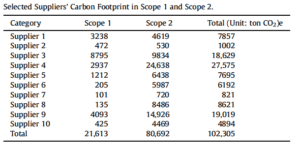Hot fudge Hyundai: The sweet taste of a well-managed supply chain

Hyundai is working with suppliers to reduce their carbon footprint. This mitigates Hyundai's risk exposure to climate change related tariffs.
Climate change threatens to increase cost and decrease sales for Hyundai
Growing public concern around climate change is generating increased risk for the automotive industry. Specifically business executives must plan for changing customer preference to products that have smaller footprints [2] and increased likelihood of tariffs for pollution that will increase the cost to manufacture automobiles [4]. While some studies have found businesses to be sluggish to acknowledge the risks of disruption caused by climate change, with one study showing 96% exposure versus an action rate of 20% [5][2], Hyundai is acting to mitigate the risk. Although South Korean organizations have on the whole shown less strategy implementation than their North American counterparts to mitigate the risks [1], Hyundai, headquarted in South Korea, has put into action concrete plans to reduce its supply chain’s environmental impact. The corporation is attempting to reduce the footprint of its supply chain to mitigate risk that its suppliers’ prices may be greatly affected by increased tariffs and consequently raise the price of the end product [4].
Actions that Hyundai is taking to decrease its sensitivity to increased costs from climate change related regulation
Hyundai has set out with the mantra “no measurement, no improvement, no innovation,” with it sights sent on quantifying and reducing its supply chain carbon footprint. The initial challenge in helping it’s suppliers to quantify their carbon footprint has been to help them find the appropriate data to collect and encourage them to invest in the high upfront cost of monitoring those metrics [3]. The corporation has developed a four metric framework for which to evaluate its suppliers. These dimensions include a lifecycle analysis of the materials, regulatory compliance, gross emissions, and the efficiency of the operation. See tables below for sample of ten example suppliers and their carbon footprints.
[4]
Through this carbon footprint quantification process, Hyundai has been able to aid its suppliers in improving their practices [4]. Hyundai’s efforts in helping these small firms to improve [1] will likely be best in the long-run for not only the individual suppliers, but certainly for Hyundai which aggregates all of the risk of these suppliers having to raise their prices. By realizing that the corporation is vulnerable to its suppliers having to raise prices to account for pollution, Hyundai has positioned itself to gain market share in the auto industry should the likely regulation and specific charges be induced on auto manufacturers’ supply chains.
Other recommended steps for Hyundai to take to reduce its climate change related risk exposure
While Hyundai is doing an excellent job of reducing the risks from possible tariffs, there were no articles found to support that Hyundai is doing much in the way of reducing the risk in its supply chain due to the natural disasters that are accompanying the advent of climate change. In order to better protect itself from risks, Hyundai should look into keeping emergency stocks of supplies, analyzing the risk of natural disasters to its suppliers, diversifying its suppliers, and considering its suppliers proximity to the manufacturing facilities [5].
Another possibility for Hyundai to further mitigate its exposure to climate change related regulation would be to enter a best practice-sharing program with other top auto manufacturers. Before engaging in such an exchange it would be wise for Hyundai to identify the industry leader in sustainable practices. It is possible that Hyundai would receive more benefit than lost in competitive advantage since it can not only apply these best practices to its base manufacturing, but with having established working relationships with its suppliers also reduce their costs and sensitivity to future climate change related risks.
Lastly, to fully capitalize on all of the good work it has been doing in reducing the carbon footprint of its vehicles, it would be advisable that Hyundai advertise all of their efforts. In a marketplace where consumers are increasingly carbon footprint conscious, Hyundai could see a significant uptick in sales in exchange for their labor [2].
Open questions related to Hyundai’s supply chain innovation
- With the US having recently withdrawn from the Paris Climate Agreement, is there a possibility that all of the work Hyundai did to mitigate its exposure to future regulation be for naught should other countries follow suit in leaving the agreement?
- How can governments incentivize and/or educate companies within their countries to mitigate the risk of their supply chains becoming prohibitively expensive should future tariffs on emissions be implemented?
(Word count: 739)
[1] Damert, M. and Baumgartner, R. (2017). Intra-Sectoral Differences in Climate Change Strategies: Evidence from the Global Automotive Industry. Business Strategy and the Environment.
[2] How Companies Think About Climate Change: A McKinsey Global Survey. (2008). [ebook] Available at: http://www.washburn.edu/faculty/rweigand/McKinsey/McKinsey-Execs-And-Climate-Change.pdf [Accessed 13 Nov. 2017].
[3] Lee, K. (2011). Carbon accounting for supply chain management in the automotive industry. Journal of Cleaner Production, 36(2012), pp.83-93.
[4] Lee, K. (2011). Integrating carbon footprint into supply chain management: the case of Hyundai Motor Company (HMC) in the automobile industry. Journal of Cleaner Production, 19(11), pp.1216-1223.
[5] The Impact of Climate Change on Extreme Precipitation and Flooding. (2016). Berkshire: FM Global, p.6.





Great essay and analysis. I’m not too worried about the impact of the US leaving the Paris Climate Agreement on Hyundai’s efforts to make its supply chain more sustainable. Since the US withdrew, two more countries have joined, making the US the only outlier, and it will probably stay that way. Additionally, individual states and cities have stepped up to pledge adherence to the standards of the Paris Climate Agreement, so Hyundai should still be incentivized to continue to improve it’s sustainability practices.
If I were Hyundai, I would be careful about how they go about advertising their efforts. I agree with you that they should explore that strategy, but they must walk a fine line to avoid the appearance of “greenwashing.”
Interesting insight that Hyundai is at risk of having its suppliers increase prices due to changing legislation. Helping its suppliers become less carbon intensive is a good move to keep costs low. It’s interesting, as you point out, that Hyundai is not helping itself and suppliers adapt to changing weather patters. Surely, climate change will have a direct effect on their operations; mitigating this effect is also important to keeping costs down. Nice job!
Very interesting article!
I totally agree that Hyundai is moving in the right direction by reducing its supply chain’s environmental impact. This represents such an imminent and material risk that the South Korean automaker should proactively try to minimize it. However, as doing so is expensive – as you point out, I also agree that the company should seek to capitalize all its good work. In addition to advertising all of its efforts (although being cautious as MS suggests in his/her comment), it occurs to me that they should explore another lever: lobbying. Although Hyundai might not be at the same level of some of its North American counterparts in terms of managing climate change risk, it seems that they are one of the most advanced players in their local industry, or even in Asia. Therefore, lobbying to push regulations up to their current standards might help them gain a relevant competitive edge. Many of the other Asian automakers, mainly those competing in the economy segment but that have managed to steal market share from Hyundai, could be caught off guard. If new regulations are pushed, suddenly, their costs would inevitably increase and they would have to either charge higher prices to customers or be willing to reduce sacrifice margins. This would put them in a very tough position as price tends to be their main differentiator and margins are thin already. Hyundai, on the other hand, would be prepared.
If such a strategy has been so successful in industries such as Mining, why not give it a try?
Nice write up! On the topic of question 1, I don’t think Hyundai’s efforts are for naught as a result of the US leaving the Paris Climate Agreement: in fact, I think it makes their work all the more imperative. While the US’ removal from the agreement definitely creates a hole, it’s a hole that can be (at least partially) filled by a consortium of large and influential corporations taking onus on themselves (whether altruistic or to indirectly benefit revenue through social impact advertising) to reduce their carbon footprint. I’d be interested to see how these best-practice sharing agreements you suggest in your paper come into play here: on one hand, it seems like a great opportunity for businesses to band together to help the greater good; on the other hand, it seems like it could create an environment where one or two players could try to gain share by benefitting from the lower cost basis one has if not forced to comply with stricter climate standards. Even so, the aggregate impact on the climate of auto manufacturers adopting best practices seems to far outweigh the risk of some outliers not complying for their personal gain.
Good work on this! I agree with the other commenters that the US leaving the Paris Climate Agreement should not discourage Hyundai from continuing their efforts to combat climate change. Even if this impacts them negatively in the short term, investing in green initiatives is a smart bet in the long run. With regard to the second question, governments must continue to actively reward companies that make investments in reducing pollution and waste in their supply chains. Companies will only make these investments when the penalties for not doing so are cost prohibitive. I agree with the author that Hyundai has a great opportunity to advertise their investments in reducing pollution. There is even an opportunity for them to highlight how these efforts are even more important given that the US government is taking a back seat in the global battle against climate change.
Great work on this, and very interesting questions. I will tackle each separately.
Q1 – With the US having recently withdrawn from the Paris Climate Agreement, is there a possibility that all of the work Hyundai did to mitigate its exposure to future regulation be for naught should other countries follow suit in leaving the agreement?
I think yes and no. Yes in the sense that it is quite concerning the speed at which 10% of its sales base (see links below) no longer ‘required’ these advancements in sustainability. I also believe that certain US states have decided to continue adhering to the fight against climate change, despite the US withdrawal from the Paris Climate Agreement (see 3rd link below).
On the other hand and as others mentioned previously, investing in sustainability is a long-term game and Hyundai should continue on its path. I would also like to add the point that, even if US as a government has taken a step back, society is well aware of climate change and this may in fact be a great PR tool to increase/boost Hyundai sales.
Global sales: https://www.cnbc.com/2017/01/02/hyundai-kia-global-vehicle-sales-fall-2-in-2016-missing-targets.html
US sales: https://www.hyundaiusa.com/about-hyundai/news/Corporate_HYUNDAI_MOTOR_AMERICA_REPORTS_SEVENTH_CONSECUTIVE_YEAR_OF_RECORD_SALES-20170104.aspx
https://www.nytimes.com/2017/09/20/climate/paris-climate-accord-trump.html
Q2 – How can governments incentivize and/or educate companies within their countries to mitigate the risk of their supply chains becoming prohibitively expensive should future tariffs on emissions be implemented?
I’m going to tackle the incentivize portion. Most governments offer different types of incentives to convince companies to go green/invest in tackling climate change, ranging from tax credits/deductions to improved access to loans and funding. I do think governments can play an even bigger role in shaping the future of sustainability, perhaps by setting up specific industry verticals that deal with addressing climate change/supporting companies in their effort to tackle climate change.